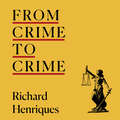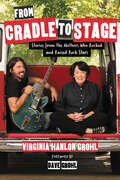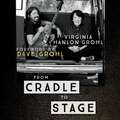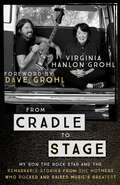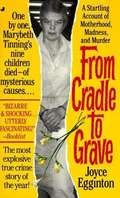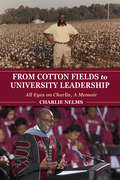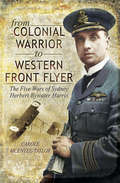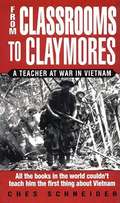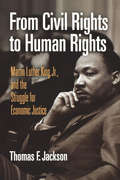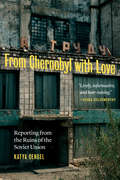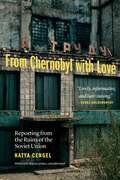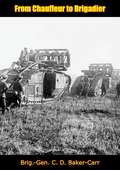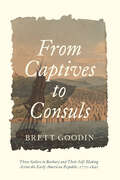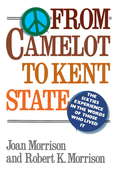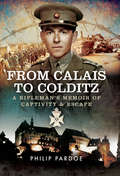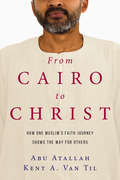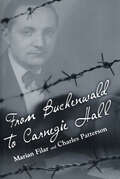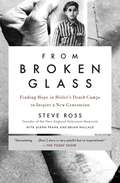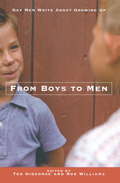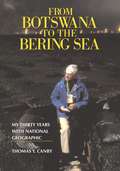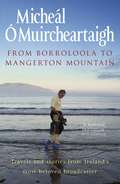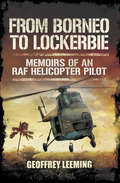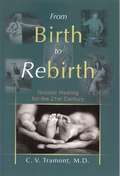- Table View
- List View
From Crime to Crime: Harold Shipman to Operation Midland - 17 cases that shocked the world
by Richard HenriquesSir Richard Henriques has been centre stage in some of the most high-profile and notorious cases of the late 20th and early 21st centuries. After taking silk in 1986, over the course of the next 14 years he appeared in no fewer than 106 murder trials, including prosecuting Harold Shipman, Britain's most prolific serial killer, and the killers of James Bulger. In 2000 he was appointed to the High Court Bench and tried the transatlantic airline plot, the Morecambe Bay cockle pickers, the killing of Jean Charles de Menezes, and many other cases. He sat in the Court of Appeal on the appeals of Barry George, then convicted of murdering Jill Dando, and Jeremy Bamber, the White House Farm killer. In From Crime to Crime Richard Henriques tells the story behind his most famous cases and includes his trenchant views on the state of the British judicial system; how it works - or doesn't - and the current threats to the rule of law that affect us all.(P) 2020 Hodder & Stoughton Ltd
From Cradle to Stage: Stories from the Mothers Who Rocked and Raised Rock Stars
by Virginia Hanlon GrohlWhile the Grohl family had always been musical-the family sang together on long car trips, harmonizing to Motown and David Bowie-Virginia never expected her son to become a musician, let alone a rock star. But when she saw him perform in front of thousands of screaming fans for the first time, she knew that rock stardom was meant to be for her son. And as Virginia watched her son's star rise, she often wondered about the other mothers who raised sons and daughters who became rock stars. Were they as surprised as she was about their children's fame? Did they worry about their children's livelihood and wellbeing in an industry fraught with drugs and other dangers? Did they encourage their children's passions despite the odds against success, or attempt to dissuade them from their grandiose dreams? Do they remind their kids to pack a warm coat when they go on tour? Virginia decided to seek out other rock star mothers to ask these questions, and so began a two-year odyssey in which she interviewed such women as Verna Griffin, Dr. Dre's mother; Marianne Stipe, Michael Stipe of REM's mother; Janis Winehouse, Amy Winehouse's mother; Patsy Noah, Adam Levine's mother; Donna Haim, mother of the Haim sisters; Hester Diamond, Mike D of The Beastie Boys' mother. With exclusive family photographs and a foreword by Dave Grohl, From Cradle to Stage will appeal to mothers and rock fans everywhere.
From Cradle to Stage: Stories from the Mothers Who Rocked and Raised Rock Stars
by Virginia Hanlon GrohlFrom Cradle to Stage shares stories and exclusive photos featuring mothers of rock icons, the icons themselves, and their Behind the Music-style relationshipsWhile the Grohl family had always been musical-the family sang together on long car trips, harmonizing to Motown and David Bowie, Virginia Grohl never expected her son to become a musician, let alone a rock star. But when she saw him perform in front of thousands of screaming fans for the first time, she knew that stardom was meant to be for her son. And as Virginia watched her son's star rise, she often wondered about the other mothers who raised children who became rock stars. Were they as surprised as she was about their children's fame? Did they worry about their children's livelihood and well-being in an industry fraught with drugs and other dangers? Did they encourage their children's passions despite the odds against success, or attempt to dissuade them from their grandiose dreams? Do they remind their kids to pack a warm coat when they go on tour?Virginia decided to seek out other celebrity mothers to ask these questions, and so began a two-year odyssey in which she interviewed such women as Verna Griffin, Dr. Dre's mother; Marianne Stipe, Michael Stipe of REM's mother; Janis Winehouse, Amy Winehouse's mother; Patsy Noah, Adam Levine's mother; Donna Haim, mother of the Haim sisters; Hester Diamond, Mike D of The Beastie Boys' mother.With exclusive family photographs and a foreword by Dave Grohl, From Cradle to Stage will appeal to mothers and music fans everywhere.(P)2017 Hachette Audio
From Cradle to Stage: Stories from the Mothers Who Rocked and Raised Rock Stars
by Virginia Hanlon GrohlVirginia Grohl, mother of Dave Grohl, had not seen any of it coming. Not the arenas of screaming fans, not Nirvana or the Foo Fighters, not the induction into the Rock and Roll Hall of Fame, and certainly not her son, Dave, performing with Sir Paul McCartney at The White House. Theirs had always been a life full of music - the Grohl family sang together on long car trips, harmonising to Motown and David Bowie - yet Virginia never expected her son to become a musician. But when Virginia saw Nirvana play for the first time to crazed applause from thousands of screaming fans, she knew nothing would ever be the same. She was the mother of a rock star.And as Virginia watched her son's star rise, she often wondered about the other mothers who raised sons and daughters who became rock stars. Were they as surprised as she was about their children's fame? Virginia often wondered about the mystical force that urges some of us to listen, to play, to surround ourselves with music. She wanted to talk about it with the other mothers whose sons and daughters were sharing stages with Dave, and she decided to seek them out wherever they were. So began a two-year odyssey, where she had conversations with such women from all over the world as Verna Griffin, Dr Dre's mother, Carolyn Williams, Pharell William's mother, Janis Winehouse, Amy Winehouse's mother, Patsy Noah, Adam Levine's mother, Donna Haim, mother to the Haim sisters and Hester Diamond, Mike D of The Beastie Boys' mother, to name just a few. From Cradle to Stage will appeal to mothers everywhere, but particularly to those with children who march (or play) to the beat of their own drum; and it's for those children who have their mothers to thank for everything. For music lovers and rock fans, it's the ultimate backstage pass-for anyone who has wondered what it's like to be on the inside...looking out at a packed arena. Featuring a foreword by Dave Grohl and exclusive family photographs, interviews are interwoven with the Grohl family story and the resultant book is a very intimate portrait of what makes a rock star.
From Cradle to Grave: The Short Lives and Strange Deaths of Marybeth Tinning's Nine Children
by Joyce EggintonShe drove a school bus in Schenectady, New York, waited on tables at a restaurant, and even worked as a nurse's aide at a pediatric ward. But this seemingly normal working woman killed her own nine children--and avoided suspicion for more than a decade. Now, investigative reporter Joyce Egginton delivers a startling glimpse into the mind of a mother who committed the unspeakable crime... the heart of a medical establishment that suspected nothing... and the soul of a community that ignored the terrible truth.
From Cotton Fields to University Leadership: All Eyes on Charlie, A Memoir
by Charlie NelmsThe renowned leader in higher education provides “a testament to the power of aspiration, character and education to overcome poverty and adversity” (Michael L. Lomax, President & CEO, United Negro College Fund).Charlie Nelms had audaciously big dreams. Growing up black in the Deep South in the 1950s and 1960s, working in cotton fields, and living in poverty, Nelms dared to dream that he could do more with his life than work for white plantation owners sun-up to sun-down. Inspired by his parents, who first dared to dream that they could own their own land and have the right to vote, Nelms chose education as his weapon of choice for fighting racism and inequality.With hard work, determination, and the critical assistance of mentors who counseled him along the way, he found his way from the cotton fields of Arkansas to university leadership roles. Becoming the youngest and the first African American chancellor of a predominately white institution in Indiana, he faced tectonic changes in higher education during those ensuing decades of globalization, growing economic disparity, and political divisiveness. From Cotton Fields to University Leadership is an uplifting story about the power of education, the impact of community and mentorship, and the importance of dreaming big.“In his memoir, the realities of his life take on the qualities of a good docudrama, providing the back story to the development of a remarkable educational leader. His is ‘the examined life,’ filled with honesty, humor, and humility. While this is uniquely Charlie’s story, it is a story that will lift the hearts of many and inspire future generations of leaders.” —Betty J. Overton, Director, National Forum on Higher Education for the Public Good
From Cotton Fields to University Leadership: All Eyes on Charlie, A Memoir (Well House Books)
by Charlie NelmsThe renowned leader in higher education provides “a testament to the power of aspiration, character and education to overcome poverty and adversity” (Michael L. Lomax, President & CEO, United Negro College Fund).Charlie Nelms had audaciously big dreams. Growing up black in the Deep South in the 1950s and 1960s, working in cotton fields, and living in poverty, Nelms dared to dream that he could do more with his life than work for white plantation owners sun-up to sun-down. Inspired by his parents, who first dared to dream that they could own their own land and have the right to vote, Nelms chose education as his weapon of choice for fighting racism and inequality.With hard work, determination, and the critical assistance of mentors who counseled him along the way, he found his way from the cotton fields of Arkansas to university leadership roles. Becoming the youngest and the first African American chancellor of a predominately white institution in Indiana, he faced tectonic changes in higher education during those ensuing decades of globalization, growing economic disparity, and political divisiveness. From Cotton Fields to University Leadership is an uplifting story about the power of education, the impact of community and mentorship, and the importance of dreaming big.“In his memoir, the realities of his life take on the qualities of a good docudrama, providing the back story to the development of a remarkable educational leader. His is ‘the examined life,’ filled with honesty, humor, and humility. While this is uniquely Charlie’s story, it is a story that will lift the hearts of many and inspire future generations of leaders.” —Betty J. Overton, Director, National Forum on Higher Education for the Public Good
From Colonial Warrior to Western Front Flyer: The Five Wars of Sydney Herbert Bywater Harris
by Carole McEntee-TaylorSydney Herbert Bywater Harris was an adventurer, a man possessed of great courage and charm, who fulfilled every schoolboy fantasy and really did 'live the dream'. The second youngest of seven children, the ordinary life held little appeal for Sydney so, in 1898, at the age of 17, he left home in Ilford for the Klondike gold rush. Arriving too late to make his fortune he decided to join the US Army.Two and a half years later, after seeing action in the Boxer Rebellion and the Philippines Insurrection, Sydney returned to England where he met and married Elsa de Verde Verder, a lady from an affluent Vermont family. A year later Sydney joined the Kings Colonials Imperial Yeomanry, later renamed the King Edward's Horse. Still seeking excitement, in August 1914 he transferred to the Royal Flying Corps and in 1916 went to France with 23 Squadron to fly the FE2b. Life expectancy for pilots on the front lines was very short and he was badly wounded while gun-spotting over enemy lines. After several months recovering he was posted to Turnberry as Chief Instructor and on the 13th August 1917, he was posted to Marske (by-the-Sea), with the rank of Lieutenant Colonel, to form and command No.2 Fighting School. In 1919 he was awarded the Air Force Cross.But war was not quite finished with Sydney. In 1936, fleeing imminent bankruptcy, he became involved with the International Brigades in the Spanish Civil War. Returning back to England he joined the RAFVR (Royal Air Force Volunteer Reserve) and when the Second World War broke out he was posted to Turnhouse as Section Controller. This really didn't suit him and, determined to see more action, at the age of 58, he arranged a transfer to France as Adjutant with No 1 Squadron where his duties included liaising with the French Air Force. He later transferred to 1 ATS near Perpignan and was one of the last to leave France with the German Blitzkrieg only a few hours away. Despite his ill health he continued to serve throughout the war and in 1947 became Commander at Marchwood Park where the members of the 'Guinea Pig' club went to recover.A remarkable life led in an era of endless possibilities.Royalties from this book will go to Help 4 Homeless Veterans who support Servicemen and women into suitable accommodation, and empower them to develop a civilian career through their links with employers and other organisations.
From Classrooms to Claymores: A Teacher at War in Vietnam
by Ches Schneider"Vietnam was a fantasy life of gunfire, blood, heat, and superhuman toil. " By late 1969, the end of the war was just over the horizon. But for Ches Schneider, a drafted schoolteacher turned infantry grunt in the deadly Central Highlands, it was just beginning. This story of a Missouri boy, told with grit and honesty, describes the stark transition from the normalcy of schooldays to the life-and-death drama endured daily in Vietnam's bloody jungles. As a soldier in the 1st Infantry Division, Schneider went out on twelve-man search-and-destroy combat missions, never knowing whether the next moment would bring an ambush, a firefight, or eternal oblivion. Later, when the Big Red One rotated back to the U. S. , he was transferred to the 1st Cav and fought it out with the NVA in the steamy jungles of Phuoc Long Province near the Cambodian border. As an ordinary man in extraordinary times, Schneider realistically captures the pain, loss, sacrifice, and courage of the men who fought for their lives even as the war wound down . . . .
From Civil Rights to Human Rights
by Thomas F. JacksonMartin Luther King, Jr., is widely celebrated as an American civil rights hero. Yet King's nonviolent opposition to racism, militarism, and economic injustice had deeper roots and more radical implications than is commonly appreciated, Thomas F. Jackson argues in this searching reinterpretation of King's public ministry. Between the 1940s and the 1960s, King was influenced by and in turn reshaped the political cultures of the black freedom movement and democratic left. His vision of unfettered human rights drew on the diverse tenets of the African American social gospel, socialism, left-New Deal liberalism, Gandhian philosophy, and Popular Front internationalism.King's early leadership reached beyond southern desegregation and voting rights. As the freedom movement of the 1950s and early 1960s confronted poverty and economic reprisals, King championed trade union rights, equal job opportunities, metropolitan integration, and full employment. When the civil rights and antipoverty policies of the Johnson administration failed to deliver on the movement's goals of economic freedom for all, King demanded that the federal government guarantee jobs, income, and local power for poor people. When the Vietnam war stalled domestic liberalism, King called on the nation to abandon imperialism and become a global force for multiracial democracy and economic justice.Drawing widely on published and unpublished archival sources, Jackson explains the contexts and meanings of King's increasingly open call for "a radical redistribution of political and economic power" in American cities, the nation, and the world. The mid-1960s ghetto uprisings were in fact revolts against unemployment, powerlessness, police violence, and institutionalized racism, King argued. His final dream, a Poor People's March on Washington, aimed to mobilize Americans across racial and class lines to reverse a national cycle of urban conflict, political backlash, and policy retrenchment. King's vision of economic democracy and international human rights remains a powerful inspiration for those committed to ending racism and poverty in our time.
From Chernobyl with Love: Reporting from the Ruins of the Soviet Union
by Katya CengelIn the wake of the fall of the Berlin Wall, the late twentieth century was a time of unprecedented hope for democracy and freedom in Eastern Europe. The collapse of the Soviet Union left in its wake a number of independent countries where the Scorpions’ 1990 pop ballad “Wind of Change” became a rallying cry. Communist propaganda was finally being displaced by Western ideals of a free press. Less than two decades ago, young writers, journalists, and adventurers such as Katya Cengel flocked from the West eastward to cities like Prague and Budapest, seeking out terra nova. Despite the region’s appeal, neither Kyiv in the Ukraine nor Riga in Latvia was the type of place you would expect to find a twenty-two-year-old Californian just out of college. Kyiv was too close to Moscow. Riga was too small to matter—and too cold. But Cengel ended up living and working in both. This book is her remarkable story. Cengel first took a job at the Baltic Times just seven years after Latvia regained its independence. The idea of a free press in the Eastern Bloc was still so promising that she ultimately moved to the Ukraine. From there Cengel made several trips to Chernobyl, site of the world’s worst nuclear disaster. It was at Chernobyl that she met her fiancé, but as she fell in love, the Ukraine collapsed into what would become the Orange Revolution, bringing it to the brink of political disintegration and civil war. Ultimately, this fall of idealism in the East underscores Cengel’s own loss of innocence. From Chernobyl with Love is an indelible portrait of this historical epoch and a memoir of the highest order.
From Chernobyl with Love: Reporting from the Ruins of the Soviet Union
by Katya Cengel2019 Foreword INDIES Award, Gold for Autobiography & Memoir Bronze Medal winner in the Independent Book Publishers Awards In the wake of the fall of the Berlin Wall, the late twentieth century was a time of unprecedented hope for democracy and freedom in Eastern Europe. The collapse of the Soviet Union left in its wake a number of independent countries where the Scorpions&’ 1990 pop ballad &“Wind of Change&” became a rallying cry. Communist propaganda was finally being displaced by Western ideals of a free press. Less than two decades ago, young writers, journalists, and adventurers such as Katya Cengel flocked from the West eastward to cities like Prague and Budapest, seeking out terra nova. Despite the region&’s appeal, neither Kyiv in the Ukraine nor Riga in Latvia was the type of place you would expect to find a twenty-two-year-old Californian just out of college. Kyiv was too close to Moscow. Riga was too small to matter—and too cold. But Cengel ended up living and working in both. This book is her remarkable story. Cengel first took a job at the Baltic Times just seven years after Latvia regained its independence. The idea of a free press in the Eastern Bloc was still so promising that she ultimately moved to the Ukraine. From there Cengel made several trips to Chernobyl, site of the world&’s worst nuclear disaster. It was at Chernobyl that she met her fiancé, but as she fell in love, the Ukraine collapsed into what would become the Orange Revolution, bringing it to the brink of political disintegration and civil war. Ultimately, this fall of idealism in the East underscores Cengel&’s own loss of innocence. From Chernobyl with Love is an indelible portrait of this historical epoch and a memoir of the highest order.
From Chauffeur to Brigadier
by Brig.-Gen. C. D. Baker-CarrOriginally published in 1930, these are the remarkable memoirs of Brigadier General Christopher D'Arcy Bloomfield Saltern Baker-Carr (1878-1949), a British Army staff officer who went on to rise through the ranks to become an important military commander during World War I.His account begins in August 1914 with his departure for the front in France and concludes four years later with his experiences at his last headquarters, situated in a small town in northern France, Caudry.“It was my unique privilege during the Great War to be closely associated with the development and organisation of the most important defensive weapon, the machine gun, and of the most important offensive weapon, the tank.“Today, perhaps, it will seem incredible that the High Command failed to appreciate the true value of the machine gun and the tank in the early stages of their development. It will seem even more incredible that, at a later period, it was necessary to scheme and struggle against official lukewarmness, at times almost indistinguishable from hostility, in order to secure the increase in the numbers of these arms, which, as was evident to everybody else, had proved themselves to be the greatest preservers of life yet discovered.“In the following pages I have endeavoured to set down an account of the difficulties encountered, of failures and successes, of high hopes brought to the ground by lack of faith and vision, of the ultimate recognition at long last, of the superiority of machinery and metal over beef and brawn.“Much of what I have written, especially in the earlier portions of the book, is, of necessity, a personal narrative, and I have described events and occurrences as I, myself, saw them.”—Brig.-Gen. C. D. Baker-Carr
From Captives to Consuls: Three Sailors in Barbary and Their Self-Making across the Early American Republic, 1770-1840 (Studies in Early American Economy and Society from the Library Company of Philadelphia)
by Brett GoodinHow three white, non-elite American sailors turned their experiences of captivity into diverse career opportunities—and influenced America's physical, commercial, ideological, and diplomatic development.Winner of the John Lyman Book Award by the North American Society for Oceanic HistoryFrom 1784 to 1815, hundreds of American sailors were held as "white slaves" in the North African Barbary States. In From Captives to Consuls, Brett Goodin vividly traces the lives of three of these men—Richard O'Brien, James Cathcart, and James Riley—from the Atlantic coast during the American Revolution to North Africa, from Philadelphia to the Louisiana Territories, and finally to the western frontier. This first scholarly biography of American captives in Barbary sifts through their highly curated writings to reveal how ordinary individuals in extraordinary circumstances could maneuver through and contribute to nation building in early America, all the while advancing their own interests. The three subjects of this collective biography both reflected and helped refine evolving American concepts of liberty, identity, race, masculinity, and nationhood. Time and again, Goodin reveals, O'Brien, Cathcart, and Riley uncovered opportunities in their adversity. They variously found advantage first in the Revolution as privateers, then in captivity by writing bestselling captivity narratives and successfully framing their ordeal as a qualification for coveted government employment. They even used their modest fame as ex-captives to become diplomats, get elected to state legislatures, and survey the nation's territorial expansions in the South and West. Their successful self-interested pursuit of opportunities offered by the expanding American empire, Goodin argues, constitutes what he calls "the invisible hand of American nation building."Goodin shows how these ordinary men, lacking the genius of a Benjamin Franklin or Alexander Hamilton, depended on sheer luck and adaptability in their quest for financial independence and public recognition. Drawing on archival collections, newspapers, private correspondence, and government documents, From Captives to Consuls sheds new light on the significance of ordinary individuals in guiding early American ideas of science, international relations, and what it meant to be a self-made man.
From Camelot to Kent State
by Joan MorrisonA look back at the major events of the 1960s, told by the voices of both the famous and those they affected, which, as a result, creates a powerful focus on the human dimension of that turbulent decade.From the Trade Paperback edition.
From Calais to Colditz: A Rifleman's Memoir of Captivity and Escape
by Philip PardoeFrom Calais to Colditz has never been published before but readers will surely agree that the wait has been worthwhile. The author was a young platoon commander when his battalion were ordered by Prime Minister Winston Churchill to defend Calais to the last man and so distract German attention from the evacuation of the BEF at Dunkirk.After an intense four day battle, the survivors were subjected to a gruelling twelve day march towards Germany. There followed incarceration in a succession of POW camps during which the author succeeded in escaping twice, both over the wire and by tunnelling, remaining at large on one occasion for twelve days. These exploits qualified him for a place in the notorious Colditz Castle, the supposed escape-proof camp. The descriptions of his colourful fellow prisoners, their captors and their extraordinary experiences are as good as any of the previous accounts and in many respects more revealing.How fortunate it is that From Calais to Colditz can now be read by a wide audience.
From Cairo to Christ: How One Muslim's Faith Journey Shows the Way for Others
by Abu Atallah Kent A. Van Til"If I were to become a Christian, it would mean not only changing my religion but changing my whole identity, and bringing shame upon my family. My whole family is Muslim, and my society and culture were Muslim. . . . Changing from Islam to Christianity would mess up my life forever." So writes Abu Atallah, who grew up in Cairo as an ordinary Egyptian Muslim. He was deeply embedded in his family, religion, and country. For a time he was part of the Muslim Brotherhood. But as he came of age, he began to encounter people who followed a different way, who called themselves Christians. And a radically new life became possible—at great cost and risk, yet with great joy. From Cairo to Christ is the remarkable story of how one Muslim man was drawn to the Christian faith, and how he later became an ambassador for Christ with a ministry in the Muslim world. Atallah has personally helped hundreds of Muslims come to Christ. This narrative sheds light on Islamic cultural dynamics and what Westerners should know about Muslim contexts. Despite the challenges facing believers from Muslim backgrounds, God is bringing surprising numbers of Muslims to Christ. Discover how the good news of Jesus transforms lives in Muslim communities around the world.
From Buchenwald to Carnegie Hall (Willie Morris Books in Memoir and Biography)
by Marian Filar Charles PattersonBefore the Nazis sent members of the Filar family to Treblinka, these were the last words Marian Filar's mother said to him: “I bless you. You'll survive this horror. You'll become a great pianist, and I'll be very proud of you.” Born in 1917 into a musical Jewish family in Warsaw, Filar began playing the piano when he was four. He performed his first public concert at the age of six. At twelve he played with the Warsaw Philharmonic Orchestra and went on to study with the great Polish pianist and teacher Zbigniew Drzewiecki at the State Conservatory of Music. After the German invasion, Filar fled to Lemberg (Lvov), where he continued his music studies until 1941, when he returned to his family in the Warsaw Ghetto. The Nazis killed his parents, a sister, and a brother, but he and his brother Joel survived as workers on the German railroad. After taking part in the Warsaw Ghetto uprising, Marian and Joel were captured and sent to Majdanek, Buchenwald, and other concentration camps. After liberation Filar was able to resume his career by studying with the renowned German pianist Walter Gieseking. In 1950 he immigrated to the United States and soon after was performing concerts with Eugene Ormandy and the Philadelphia Orchestra. He made his Carnegie Hall debut on New Year's Day, 1952. He became head of the piano department at the Settlement Music School in Philadelphia and later a professor of music at Temple University, while continuing to perform in Europe, South America, Israel, and the United States. Filar does not end his story with liberation but with the fulfillment of his mother's blessing. Without rancor or bitterness, his memoir comes full circle, ending where it began—in Warsaw. In 1992 Filar traveled to Poland to visit the school next to what had once been the Umschlagplatz, the place from which Jews had been sent to Treblinka and where he said farewell to the mother who blessed him.
From Broken Glass: My Story of Finding Hope in Hitler's Death Camps to Inspire a New Generation
by Ray Flynn Steve Ross Glenn Frank Brian WallaceFrom the survivor of ten Nazi concentration camps who went on to create the New England Holocaust Memorial, an inspiring memoir about finding strength in the face of despair.On August 14, 2017, two days after a white-supremacist activist rammed his car into a group of anti-Fascist protestors, killing one and injuring nineteen, the New England Holocaust Memorial was vandalized for the second time in as many months. At the base of one of its fifty-four-foot glass towers lay a pile of shards. For Steve Ross, the image called to mind Kristallnacht, the Night of Broken Glass in which German authorities and civilians ransacked Jewish-owned buildings with sledgehammers.Ross was eight years old when the Nazis invaded his Polish village, forcing his family to flee. He spent his next six years in a day-to-day struggle to survive the notorious camps in which he was imprisoned, Auschwitz-Birkenau and Dachau among them. When he was finally liberated, he no longer knew how old he was, he was literally starving to death, and everyone in his family save for his brother had been killed.Ross learned in his darkest experiences--by observing and enduring inconceivable cruelty as well as by receiving compassion from caring fellow prisoners--the human capacity to rise above even the bleakest circumstances. He decided to devote himself to underprivileged youth, aiming to ensure that despite the obstacles in their lives they would never experience suffering like he had. Over the course of a nearly forty-year career as a psychologist working in the Boston city schools, that was exactly what he did. At the end of his career, he spearheaded the creation of the New England Holocaust Memorial, a site millions of people including young students visit every year.Equal parts heartrending, brutal, and inspiring, From Broken Glass is the story of how one man survived the unimaginable and helped lead a new generation to forge a more compassionate world.
From Boys to Men: Gay Men Write About Growing Up
by Robert Williams Ted GideonseMore than an anthology of coming out stories, "From Boys to Men" is a stunning collection of essays about what it is like to be gay and young, to be different and be aware of that difference from the earliest of ages. <P><P> In these memoirs, coming out is less important than coming of age and coming to the realization that young gay people experience the world in ways quite unlike straight boys. Whether it is a fascination with soap opera, an intense sensitivity to their own difference, or an obsession with a certain part of the male anatomy, gay kids or kids who would eventually identify as gay have an indefinable but unmistakable gay sensibility. Sometimes the result is funny, sometimes it is harrowing, and often it is deeply moving. Essays by lauded young writers like Alex Chee (Edinburgh), Aaron Hamburger (Faith for Beginners), Karl Soehnlein (The World of Normal Boys), Trebor Healy (Through It Came Bright Colors), Tom Dolby (The Trouble Boy), David Bahr, and Austin Bunn, are collected along with those by brilliant, newcomers such as Michael McAllister, Jason Tougaw, Viet Dinh, and the wildly popular blogger, Joe. My. God. "
From Botswana to the Bering Sea: My Thirty Years With National Geographic
by Thomas CanbyNational Geographic has been called a window on the world and a passport to adventure. Each month an estimated forty million people in 190 countries open its pages and are transported to exotic realms that delight the eye and mind. Such widespread renown gives the magazine's writers unmatched access to people and places, as doors that are closed to the rest of the journalistic world open wide. Thomas Y. Canby was a National Geographic writer and science editor from 1961 to 1991, a time during which the Society grew by leaps and bounds and the resources available to staff were seemingly limitless. In From Botswana to the Bering Sea, he gives readers a look at the life of a National Geographic field staffer and an insider's view of the fascinating dynamics within the magazine's offices. Canby's assignments dealt with issues of global concern, and his travels took him to the farthest reaches of the planet. This book allows the reader to share in his experiences -- from a Filipino rice harvest capped by a feast of deep-fried rats, to impoverished villages of Asia and Africa gripped by the world's most widespread famine, to seal hunting and dog sledding with Eskimos in the Canadian high Arctic. Readers match wits with paranoid guardians of the secret Soviet space program, skirt land mines in the flaming oil fields of Kuwait, and dodge death while scuba diving to an archaeological site in a Florida sinkhole. The book also gives insight into the magazine's inner workings: how article subjects are chosen and assigned; how writers interact; how prolonged trips to impossibly remote destinations are planned; how staffers operate in the field. Working for National Geographic has been called "the best job in the world." From Botswana to the Bering Sea describes that unique job, and answers the question Canby and his colleagues are so often asked: "So, what is it like to work for National Geographic?"
From Borroloola to Mangerton Mountain: Travels and Stories from Ireland's Most Beloved Broadcaster
by Micheal O'MuircheartaighMicheál Ó Muircheartaigh is best known as the voice of the GAA. But his interests and enthusiasms – sporting and non-sporting – go far beyond the fields of Gaelic games. In his new book, the follow-up to his bestselling memoir From Dún Síon to Croke Park, Micheál brings us along on his travels around the world, and to the villages, townlands and sporting fields of the four provinces of Ireland. He recalls great days at the races and in sporting stadiums big and small, and great nights in the dance halls. Above all, he tells the stories of these places and the people he has encountered there – stories told as only Micheál can tell them.
From Borneo to Lockerbie: Memoirs of an RAF Helicopter Pilot
by Geoffrey LeemingA pilot discusses his missions around the world as he chronicles his career with Britain’s Royal Air Force in the 1960s, ’70s, and ’80s.In 1961 Geoffrey Leeming achieved his boyhood ambition to become a RAF pilot. After a period as co-pilot on the tanker variant of the Valiant bomber, a sudden change of circumstances resulted in most of his subsequent service flying being as a helicopter pilot. The helicopter most in use at this time was the Whirlwind, a good aircraft but of limited performance and lacking the technical aids enjoyed by later types of helicopters.He next flew in the little-known Borneo Confrontation of the 1960s. Living in primitive jungle bases alongside loyal and friendly natives, the Whirlwind crews supported the land forces operating along the Indonesian border with long and hazardous flights over dense, frequently uncharted, jungle.Most of the Author’s remaining helicopter service was in the Search and Rescue role, firstly from RAF Lossiemouth, then from RAF Valley, flying in the mountains and over the surrounding seas of the Scottish Highlands and Snowdonia. Many lives were saved by Geoffrey and his crewmen in weather conditions frequently exceeding the safety limits in which they were supposed to operate.His final postings were as an instructor and as commander of the Search and Rescue Training Unit at Valley. This period culminated in his traumatic involvement in the immediate aftermath of the explosion of the Pan Am airliner over Lockerbie.From Borneo to Lockerbie is an exciting flying memoir enhanced by the Author's natural modesty.
From Bordello to Ballot Box: A First-hand Account of Legal Prostitution and Political Corruption
by Jessi Winchester W. Lane StartinAutobiography
From Birth To Rebirth: Gnostic Healing For The 21st Century
by Charles V. TramontFrom Birth to Rebirth is the heart-warming true story of a dedicated obstetrician whose interest in hypnosis develops into a passion for using past-life regression as an exciting healing modality. After making his way through the rigors of medical training and the trenches of daily practice, Dr. Tramont now finds himself evolving into a pragmatic Gnostic. For thousands of years, Gnostics have believed that liberation comes from knowledge of who you are, why you are here, and where you came from. Far from being an ancient, obscure, and little-understood theology, Gnosticism is emerging today as newly valid, mainstream, and clearly relevant. In From Birth to Rebirth you will find yourself sharing Dr. Tramont's excitement as his curiosity regarding past lives escalates into full-blown research that takes him down the extraordinary pathway of spiritual enlightenment. His growing interest in therapeutic hypnosis guides him through the complex domain of the mind as he begins to discover other dimensions and the significance of previous lives to present health. To Dr. Tramont's amazement, guiding individuals through therapeutic regressions of their previous lives enables them to successfully heal themselves of many emotional and physical problems. His discovery of the extreme effectiveness of this rather miraculous method of healing has profoundly affected the way he views medicine, and, for that matter, even the nature of reality itself. In From Birth to Rebirth you will accompany Dr. Tramont on a wild ride as he encounters surprises at every turn and learns to listen to his intuition a "" the very voice of his soul. From the shackles of conventional medicine springs a safe, inexpensive, non-invasive, and extremely successful alternative healing method, a modality that is essential for the 21st Century.
